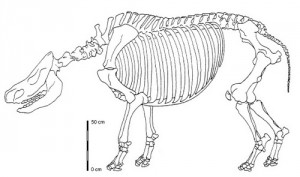MONDAY, 21 JUNE 2010
Despite outliving the Ice Age, the Hundsheim rhinoceros rapidly disappeared without any effective changes to its environment, becoming foe to two more specialised and less ecologically-diverse rhino species that monopolized the food supply in particular climates. German researchers at the Senckenberg Research Institute and the University of Hamburg have explained why, after almost a million years of survival through testing conditions, the Hundsheim rhinoceros (Stephanorhinus hundsheimensis) suddenly disappeared.By examining the dental fossils of the rhino, the team were able to identify an extremely diverse dietary spectrum and tolerance to differing ecological conditions, allowing the species to survive harsh conditions, such as the Ice Age, by dominating forests and open plains. Yet approximately half a million years ago, two new, highly specialised rhinoceros species developed during periods of extended cold and hot periods. The anatomical characteristics of these novel types (Stephanorhinus hemitoechus and Stephanorhinus kirchbergensis) suggest that they were better able to process and consume steppe and forest nutrition respectively, introducing unprecedented competition, with entirely different feeding strategies, for the Hundsheim rhino.
Despite being attributed with the broadest tolerance to vegetation of any known species, living or extinct, the study indicates that this non-specialised tolerance was fundamental to Hundsheim rhino's extinction, despite a generally benign (or even favourable) ecology and without interference by early humans.
The results are published in the Quaternary Science Reviews [1].
Written by Taylor Burns

